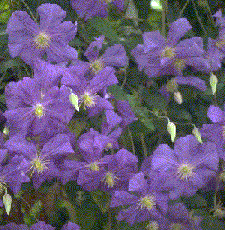Clematis 'Perle d'Azur'




It may seem a little tardy to be taking our first notice of
the Jackmanii breed in September, since these are universally known as 'summer' clematis.
But they do not stop with summer; most of them are Fall (autumn - Ed) clematis as well.
One of the family traits of this one, the beloved 'Perle d'Azur,' is its very long period
of bloom.
A few years ago when the editor of 'Clematis International' invited the members of the Society to list their favorite clematis, it was 'Perle d'Azur' that came in first in the voting. When general gardening writers turn to clematis, 'Perle d'Azur' usually wins an endorsement, often an affectionate one. And rightly so. It is vigorous, relatively easy to grow, abundant as well as long-blooming, and has a flower of singular freshness: light violet fading quickly toward sky-blue, with a flush of pink at the midribs adding a touch of spice, and a bright greenish-yellow eye.
 The plant, very tall and rangy, adapts well to
most of the favorite garden uses of clematis -- for arches, wall-plantings, and
combinations with tall hosts such as trees and climbing roses. It does have one
shortcoming -- or perhaps one should say longcoming -- from some gardeners point of view.
Since a mature specimen may climb to 15' or even more, with relatively long distances
between the nodes, it is not a wise choice for container planting, and it can easily get
too big for a small garden, even if accorded the hard early pruning that is standard for
Group III clematis. Brave souls who want to try it anyway can rein the plant in somewhat
by a second fairly sharp pruning when the stems approach eye-level, though this treatment
may bring on a considerable mass at middle height. There is another option for gardeners
without the headroom for 'Perle d'Azur': the New-Zealand-bred 'Prince Charles.' It could
almost be called a half-sized 'Perle d'Azur,' compact in size and free-flowering, with
smaller blossoms of the same cheerful blue, lacking only the flush of pink along the
midribs. Still, for those gardeners with Sissinghurst in the back of their minds, only
'Perle d'Azur' will do.
The plant, very tall and rangy, adapts well to
most of the favorite garden uses of clematis -- for arches, wall-plantings, and
combinations with tall hosts such as trees and climbing roses. It does have one
shortcoming -- or perhaps one should say longcoming -- from some gardeners point of view.
Since a mature specimen may climb to 15' or even more, with relatively long distances
between the nodes, it is not a wise choice for container planting, and it can easily get
too big for a small garden, even if accorded the hard early pruning that is standard for
Group III clematis. Brave souls who want to try it anyway can rein the plant in somewhat
by a second fairly sharp pruning when the stems approach eye-level, though this treatment
may bring on a considerable mass at middle height. There is another option for gardeners
without the headroom for 'Perle d'Azur': the New-Zealand-bred 'Prince Charles.' It could
almost be called a half-sized 'Perle d'Azur,' compact in size and free-flowering, with
smaller blossoms of the same cheerful blue, lacking only the flush of pink along the
midribs. Still, for those gardeners with Sissinghurst in the back of their minds, only
'Perle d'Azur' will do.
As the name suggests, this hybrid was bred in France. It was introduced by Francois
Morel in 1885.
Webmaster's note:- Blue clematis are notoriously difficult to photograph. Pigments
within the sepals can reflect light wavelengths which, whilst invisible to the naked eye,
affect the photographic image. Coupled with the additional affects that different PC
monitor screens can bring, you should be aware that the true colour of clematis Perle
d'Azur is pale/light blue, with no trace of violet. Return to
top of page
